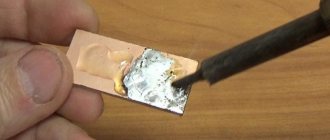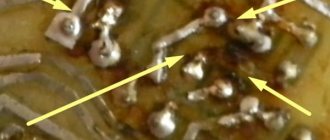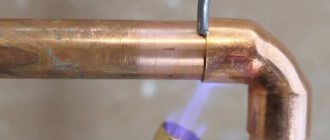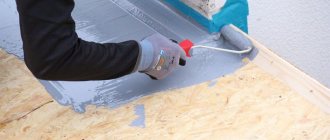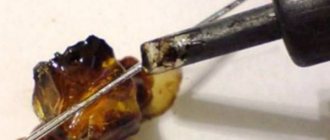Electrical appliances sometimes stop working and need to be repaired. The cause of the malfunction may be a failed microcircuit, any part, or a disconnected contact. Very often, problems can be solved at home by replacing a broken part or soldering a loose contact. You will need rosin for soldering and a soldering iron.
What is rosin needed for?
Rosin works well as a flux, but is also used to solve other problems. It imparts the desired properties to paint coatings and is often found in some plastic alloys. The substance is also excellent for treating strings of musical instruments, bows and ballet shoes.
Interesting materials:
What can you do using the Internet? What can you do with champagne corks? What can you do with empty bottles? What can you do with a vacuum cleaner? What can you do with torn tights? What can you do with a hat if it is stretched? What can you do with Silica Gel? What can you do with highly sticky slime? What can you do with soy sauce? What can you do with dry cream?
Physico-chemical properties and composition
Before looking at how to melt rosin, it's worth considering what goes into it. The composition of the material is quite simple, since a person will need only two main components for preparation. most often this is rosin itself and alcohol, which is used as an organic solvent. With proper preparation and adherence to the technological regime, the final product looks like a homogeneous substance.
Using alcohol for liquid rosin
Water can be used together with alcohol, but it is used as an additional material, since it cannot dissolve the flux on its own. Factory brands also use additional corrosion inhibitors, additives, propanol and other elements.
The density of the liquid depends on the amount of rosin itself in the composition. The properties affecting soldering almost completely replicate those possessed by solid tallow rosin. But in the dissolved version they do not appear so strongly. Due to increased spreadability, the liquid gets into all the small irregularities that exist in the metal and this gives a much higher level of bonding than in initially solid flux brands. The main chemical property here is the neutrality of the environment, therefore, the composition is suitable for use with almost any part.
How to melt rosin at home
Flux is a substance, both organic and inorganic, that removes oxides from soldered conductors, reduces surface tension, and also improves the uniformity of spreading of molten solder. In addition to its main purpose, flux can protect contacts from environmental influences, but it should be noted that not all types of fluxes have this property.
Depending on the need, flux can be in the form of liquid, powder or paste.
Solder pastes are also produced that contain solder particles along with flux, and all modern solders are a tube of solder inside which there is a flux filler.
According to the temperature regime and activity interval, fluxes can be divided into low-temperature (up to 450 degrees) and high-temperature (more than 450 degrees). In addition, the flux can be aqueous or anhydrous.
Based on their chemical properties, all fluxes can be divided into acidic (active) and acid-free. In addition, there are also activated and with anti-corrosion protection.
Active fluxes
mainly consist of hydrochloric acid and chloride or fluoride metals. The pharmaceutical drug acetylsalicylic acid (aspirin) has long been used as an active flux. These fluxes very intensively dissolve the oxidized layer on the surface of the metal, and the soldering immediately becomes high-quality and durable, but the flux residue after soldering causes intense corrosion of the joint and the base metal in the future. Therefore, it is recommended to wash off all flux residues that remain at the soldering site.
When soldering radio-electronic elements, the use of active fluxes is not permissible, since over time their residues still corrode the place where thin radio elements are soldered.
Acid-free fluxes
, mainly these are rosin and fluxes prepared on its basis with the addition of alcohol, turpentine or glycerin. During the soldering process, rosin cleans the surface of oxides and also protects it from oxidation. At a temperature of 150 degrees, rosin dissolves the oxides of lead, tin and copper, cleaning their surface during the soldering process and the soldered joint becomes shiny and beautiful. But most importantly, unlike active fluxes, rosin fluxes do not cause corrosion and corrosion of metal. Copper, bronze and brass are soldered using rosin fluxes.
Activated fluxes
, mainly, in addition, they consist of rosin to which a small amount of hydrochloric acid or phosphate aniline, salicylic acid or diethylamine hydrochloride is added.
These fluxes are used for soldering the bulk of metals and alloys (iron, steel, high-quality stainless steel, copper, bronze, zinc, nichrome, nickel, silver), even oxidized elements from copper alloys in the absence of preparatory cleaning.
Activated fluxes are considered to be LTI fluxes, which contain ethyl alcohol (66 - 73%), rosin (20 - 25%), aniline hydrochloride (3 - 7%), triethanolamine (1 - 2%). LTI flux gives excellent results when using tin solders POS-5 and POS-10, providing increased strength of the soldered joint.
Anti-corrosion fluxes
used for soldering copper and copper alloys, constantan, silver, platinum and its alloys. They contain phosphoric acid with the addition of various organic compounds and solvents. Some anti-corrosion fluxes contain organic acids. Residues of these fluxes do not cause corrosion.
VTS flux, for example, consists of 63% of those. Vaseline, 6.3% triethanolamine, 6.3% salicylic acid and ethyl alcohol. Remains of flux are removed by wiping the part with alcohol or acetone.
Protective fluxes protect the previously cleaned metal surface from oxidation and do not have a chemical effect on the alloy. This group includes inactive materials: wax, petroleum jelly, olive oil, sweet powder, etc.
For brazing of carbon steels and cast iron
They use borax (sodium tetraborate), which appears as a white crystalline powder. Borax melts at a temperature of – 741° C.
For soldering brass parts
With silver solders, a mixture of 50% sodium chloride (table salt) and 50% calcium chloride is used as a flux. The melting point of the mixture is – 605° C.
For soldering aluminum
You can use fluxes that usually contain 30-50% potassium chloride.
For soldering stainless steel
, hard and heat-resistant alloys, copper-zinc and copper-nickel solders use a mixture consisting of 50% borax and 50% boric acid, with the addition of zinc chloride.
Active fluxes are washed off with a hairbrush or an ordinary toothbrush, using warm water or alcohol.
For soldering copper conductors, and often these are the ones used in electrical and electronics, “liquid rosin” will work as a reliable means in the form of flux. For those who don’t know, this is pine resin – a pure environmental product.
How to prepare liquid rosin yourself?
1. We crush the rosin crystal into dust using crushed powder or wrapping it in a cloth and tapping it with a hammer. On a large scale, some craftsmen manage to use the Soviet manual meat grinder. The means are not important, the main thing is to achieve uniform fine dust from rosin crystals.
2. All dust must be filled with alcohol with a ratio of 1:1.5 (rosin: alcohol). It is convenient to do this using the same alcohol bottle. At the pharmacy you can buy alcohol with salicylic acid, such a solution itself can serve as a flux, and although the percentage of salicylic acid is very small, such “alcohol” is the best option for enhancing the desired properties of the flux. Next, pour rosin into half a bottle of alcohol until the desired ratio of components appears and make sure that about 1/5 of the bottle remains free!
3. Close our bottle (or other container) and place it in a container with warm water (60-80C). When the solution heats up, we begin to vigorously shake the solution so that it dissolves into a homogeneous mass. It will work much better and faster in hot water.
Then the resulting flux is poured into syringes for ease of use, or into bottles with a brush, like nail polish.
Article rating:
Save to:
How to melt rosin at home Link to main publication
Is it possible to replace alcohol?
Some experienced soldering workers who are trying to save alcohol for other purposes advise using cheap colognes. The recommendation is controversial. It will smell nice, but the additives contained in the perfume can harm the soldering area.
Advice to use vodka instead of alcohol is also not very legitimate. Rosin is an organic product and does not dissolve well in water. Vodka is a mixture of alcohol and water. It is much more difficult to dissolve resin in a vodka mixture, even if the vodka is of high quality.
Considering that at home, flux consumption is measured in moderate quantities, you can buy medical alcohol. The guaranteed quality of the alcohol-rosin mixture is worth the effort . In practice, homemade flux, made correctly, is not inferior to commercial products.
What you need for cooking
Before you start working on creating liquid rosin for soldering, you need to prepare all the ingredients and tools. For melting you will need rosin, water to dilute the thick mixture and alcohol. The tools you will need are:
- a gas stove or a special burner; solid pieces and liquid will be heated on them until they dissolve;
- a spoon to stir and dose the substance;
- a cup or mortar where rosin is crushed until fine;
- wooden masher;
- a jar for storing the resulting crushed flux.
Types of rosin solder
Currently, such solder with rosin is manufactured in several versions. It is customary to distinguish such filler material depending on the rosin content, wire thickness and a number of other features. There is a choice of materials for both home use and soldering on an industrial scale. This solder is produced in the form:
- In reels. This is a universal option for surfacing material that can be used by both professional welders in workshops and ordinary homeowners for soldering at home. The thickness of the wire can vary from 0.8 to 2 millimeters. Note that using such coils is extremely convenient. You just need to select the appropriate brand of solder and wire thickness.
- In a tube. This type of solder is made exclusively for home use. Such a tube contains a minimum of material, so if large volumes are needed, you should either buy a large number of tubes at once or choose solder in a coil.
- In the bays. A large amount of material is used, so this design is intended primarily for industrial use. The thickness of the wire can be varied, depending on the specific needs of customers. The coils themselves can be made in different sizes, which somewhat simplifies their use.
Physico-chemical properties of the solder used
The classic composition of such solder with rosin is considered to be tin-lead soft alloys. The tin content is 60% and lead 40%. Accordingly, such a composition gives such solder certain physical properties. The presence of rosin allows for excellent flexibility, as a result of which, before welding, you can select the right amount of such material and correctly position it in the seam. It must be taken into account that such a composition has a low melting point, so it is not possible to use it for joining refractory metals. At the same time, we note that such solder penetrates in a liquid state into all cavities and irregularities, which ensures the strength of the connection. But at the same time, such an additive does not penetrate into the base material.
Low melting temperatures ensure ease of soldering. Lead adds fluidity to the material, but one should take into account the fact that lead may contain toxic fumes, so it is best to perform soldering in a ventilated area
No further precautions are required when soldering.
How to do it yourself
Many home craftsmen prefer to prepare alcohol-rosin flux with their own hands. In this case, they are confident in the content, and the process takes a few minutes.
First, the resin must be thoroughly crushed. The better this is done, the faster the uniform distribution of all substances in the solvent will occur. The result is a high-quality alcohol-rosin flux.
You can wrap a piece in thick fabric. Some solders advise using cellophane, although it is less durable. It may tear during subsequent procedures.
The wrapped rosin is placed on a sturdy table, then methodically smashed with a hammer to a powdery state. The most dexterous craftsmen manage to use ordinary meat grinders for grinding.
In other practices, crushed rosin in a sheet is rolled out with force with a rolling pin or a thick bottle. The main goal is clear. To prepare alcohol-rosin flux, you need to obtain a dusty powder.
After grinding, the resin is carefully poured into a bottle or vial. Many people like containers for nail polish or perfumes and cosmetics. Dust should not fly across the table. You need to get used to it and do it carefully.
Then medical alcohol is poured into the bottle. The composition of the alcohol-rosin flux is almost ready. The recommended liquid to dry ratio is 2 to 3.
If you need a more viscous flux, you can increase the proportion of resin. Each master can choose the concentration of the rosin solution in alcohol independently, focusing on personal experience, the specifics of the work to be done, and the nature of the details.
If the pieces of resin were not crushed enough, it will be a little more difficult to dissolve the rosin. You will have to wait a couple of days for the alcohol-rosin flux to become homogeneous.
Main advantages
Each material has certain advantages and disadvantages; rosin has proven itself in soldering operations for many years and is still used today. Main advantages of the material:
- Dielectric properties help avoid unnecessary contacts on the solder surface.
- Affordable price compared to analogues, available for free sale at any radio electronics outlets.
- The soldering process using the product can be carried out regardless of the environment, humidity level, or air temperature.
- The properties of the product are protected from exposure to moisture and have a long shelf life.
- Prevents the formation of rust deposits on metal structures and degreases the product.
Rosin for soldering
It is allowed to use a natural product without personal protective equipment, due to the lack of toxicity. The process of use is not difficult; you can independently make the necessary concentration and type for convenient work.
Types of flux
For different applications, rosin is available in pure and diluted form. There are three types of fluxes based on colophon resin: solid, liquid and gel. Liquid and gel-type fluxes are more expensive and difficult to produce.
It is acceptable to use rosin-based fluxes for small-sized components of a certain metal composition. Other types of fluxes are used for processing large compounds, complex alloys, rare metals and on an industrial scale.
- Solid flux is rosin in its pure form. It is the most popular and has both undoubted pros and cons. The main disadvantage is the inconvenience and inaccuracy of application to hard-to-reach solder areas.
- Flux based on an alcohol solution, diluted in equal proportions of alcohol and solid rosin. It is very convenient when applying it with a brush to the surfaces of parts that will be connected by soldering.
- Gel-based rosin flux. The viscous consistency allows you to accurately dose the applied composition and easily process the most difficult areas of the parts to be joined. The gel takes longer to dry compared to an alcohol-based composition. This gives some time for soldering; it is more plastic and pliable compared to solid rosin flux.
Liquid or gel flux is first applied with a brush to the soldering areas and begins to work without simultaneous exposure to temperature.
Pine rosin GOST 19113 84
Table. Physico-chemical parameters of pine rosin according to GOST 19113-84.
| Indicator name | Norm | Method of analysis | ||
| highest grade OKP 24 5372 0120 | 1st grade OKP 24 5372 0130 | 2nd grade >OKP 24 5372 0140 | ||
| 1. Appearance | Transparent, glassy or with air bubbles mass | According to clause 4.2 | ||
| 2. Color intensity | X, WW, WG | X, WW, WG, N | M, K, Y, H, G | According to GOST 17823.4 |
| 3. Mass fraction of water, %, no more | 0,2 | 0,2 | 0,2 | According to GOST 16399 |
| 4. Mass fraction of ash, %, no more | 0,03 | 0,04 | 0,04 | >According to clause 4.3 |
| 5. Mass fraction of mechanical impurities, %, no more | 0,03 | 0,04 | 0,04 | According to clause 4.4 |
| 6. Softening temperature, °C, not lower | 69 | 68 | 66 | GOST23863, method A |
| 7. Acid number, mg KOH per 1 g of product, not less | 169 | 168 | 166 | According to GOST 17823.1 and clause 4.5 of this standard |
| 8. Tendency to crystallize | No honey porous sediment | According to clause 4.6 | ||
| 9. Mass fraction of unsaponifiable substances, %, no more | 6,0 | 6,5 | 7,5 | According to clause 4.7 |
Advantages
- This is the simplest and most affordable flux that can be found in almost any market;
- The cost of rosin is relatively low, so it will cost less than any other flux;
- The material has a relatively low melting point, which allows it to be used even when soldering at low temperatures;
- Suitable for many soldering applications, especially at home;
- But it is exposed to moisture, and also has practically no shelf life;
- Fights oxide films on the surface;
- The material is non-toxic and can be used even without the use of special protective equipment.
Flaws
- Rosin has a relatively low activity, so after its first use you may not get the desired effect;
- The substance is hygroscopic, so even after soldering it can absorb moisture from steam, which leads to corrosion of the metal in the joint;
- This flux is not universal, so it can only be used for simple connections, therefore, soldering stainless steel and other complex procedures cannot be performed with its help;
- The material is quite fragile, therefore, during storage and transportation, all these features must be taken into account.
Kinds
There are several varieties, which determines what rosin is used for soldering. Here you need to highlight the main types:
Resin - got its name due to the fact that it is obtained from the resin of coniferous trees. Pine is most often used, as it is the most affordable wood. The main distinguishing feature of this rosin is that it does not contain fatty acids.
Gum rosin
- Extraction – obtained through the extraction method. Gasoline is used for extraction, and coniferous wood is used as the main raw material. If we compare such material with gum rosin, then in this case it will be darker. It also has a lower softening point, which is 52-58 degrees Celsius. The acid number is approximately 15-155, and the fatty acid content reaches 12%. If you subject this rosin to chemical clarification, its properties will approach those of gum.
- Tallow is a by-product that is obtained in cellulose sulfate production. This material is obtained from sulphate soap. There are several varieties here, depending on the properties of the material. The highest grades are very similar in characteristics to gum rosin.
Tall rosin
How can I replace rosin for soldering?
Having examined in detail what rosin for soldering is, we have already found out that it is a flux. Thus, if it is not there, then you can use any other flux to replace it. When brazing occurs, this material may not even have the desired effect. Borax, which is a welding flux, is sometimes used as a replacement.
Soldering borax instead of rosin
Rosin soldering technology
Having found out why rosin is used for soldering, all that remains is to learn how to use it correctly. Before starting this process, you should clean the contacts and then tin them. To carry out tinning, the output of the part that will be soldered, you should place a piece of solid rosin on it, which has not been subjected to heat treatment. After this, you need to press it with a soldering iron heated to the desired temperature.
After this, you can already melt the solder by placing it at the soldering point and running the soldering iron tip over it. If the material is poorly processed, then there is a possibility that the solder will not stick to the surface, so you should not skimp on rosin and sometimes it is better to take it with a reserve. Under no circumstances should the parts be allowed to move until the composition has hardened. If tinning went well, then soldering will be almost instantaneous, since the solder completely envelops the prepared area and you just have to wait until it cools down. All this practically does not depend on what type of rosin is used, since in practice they behave the same.
